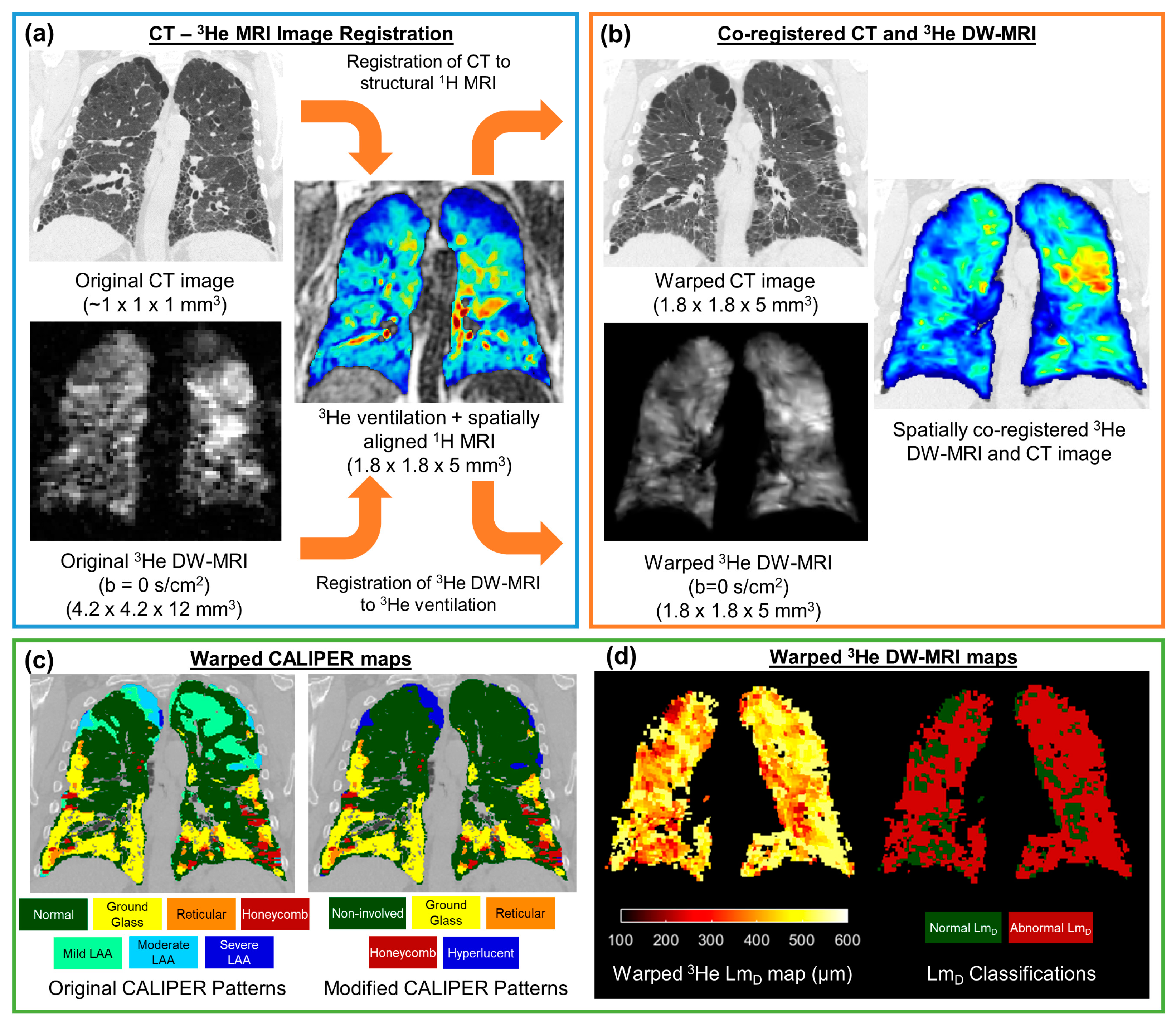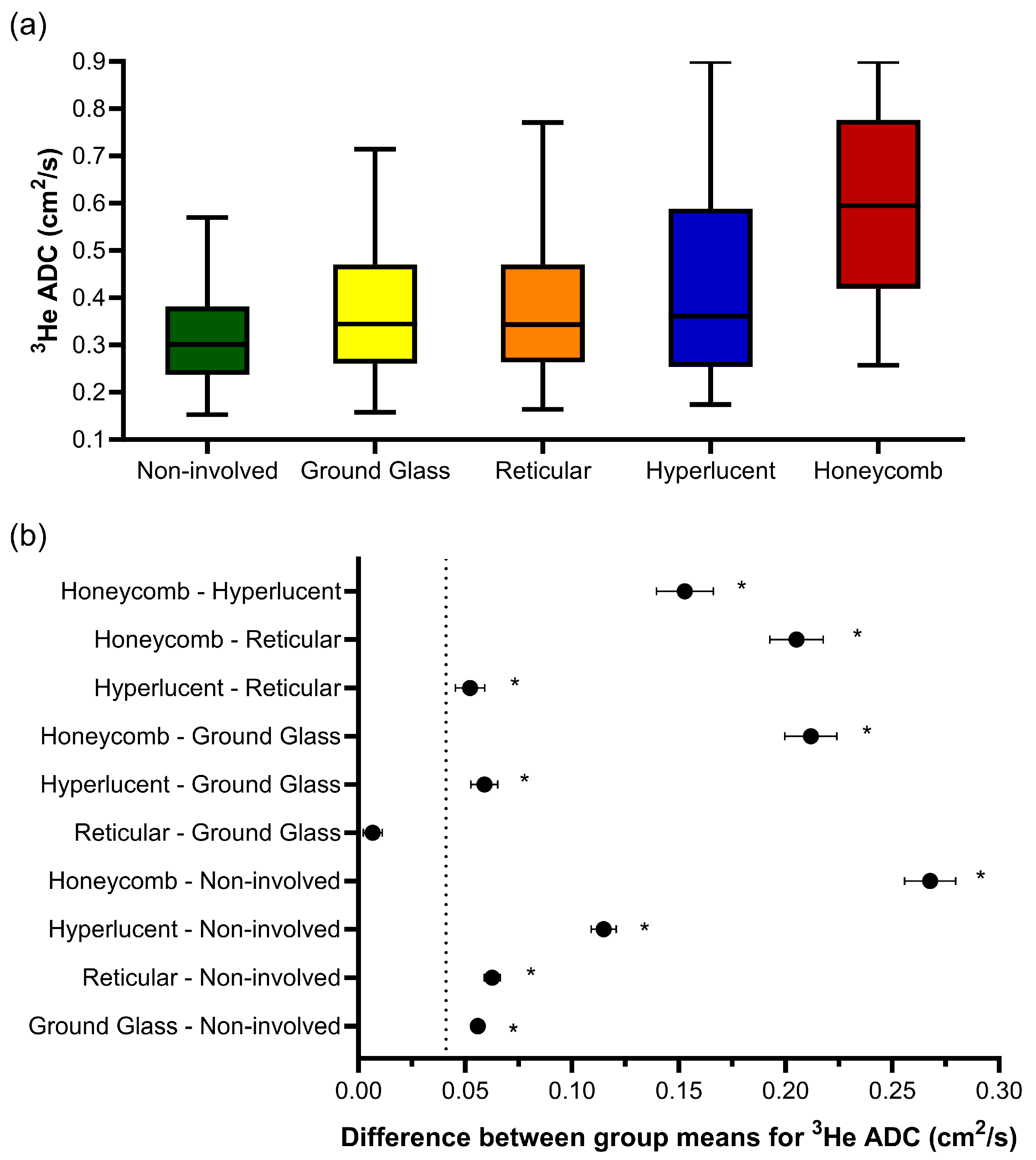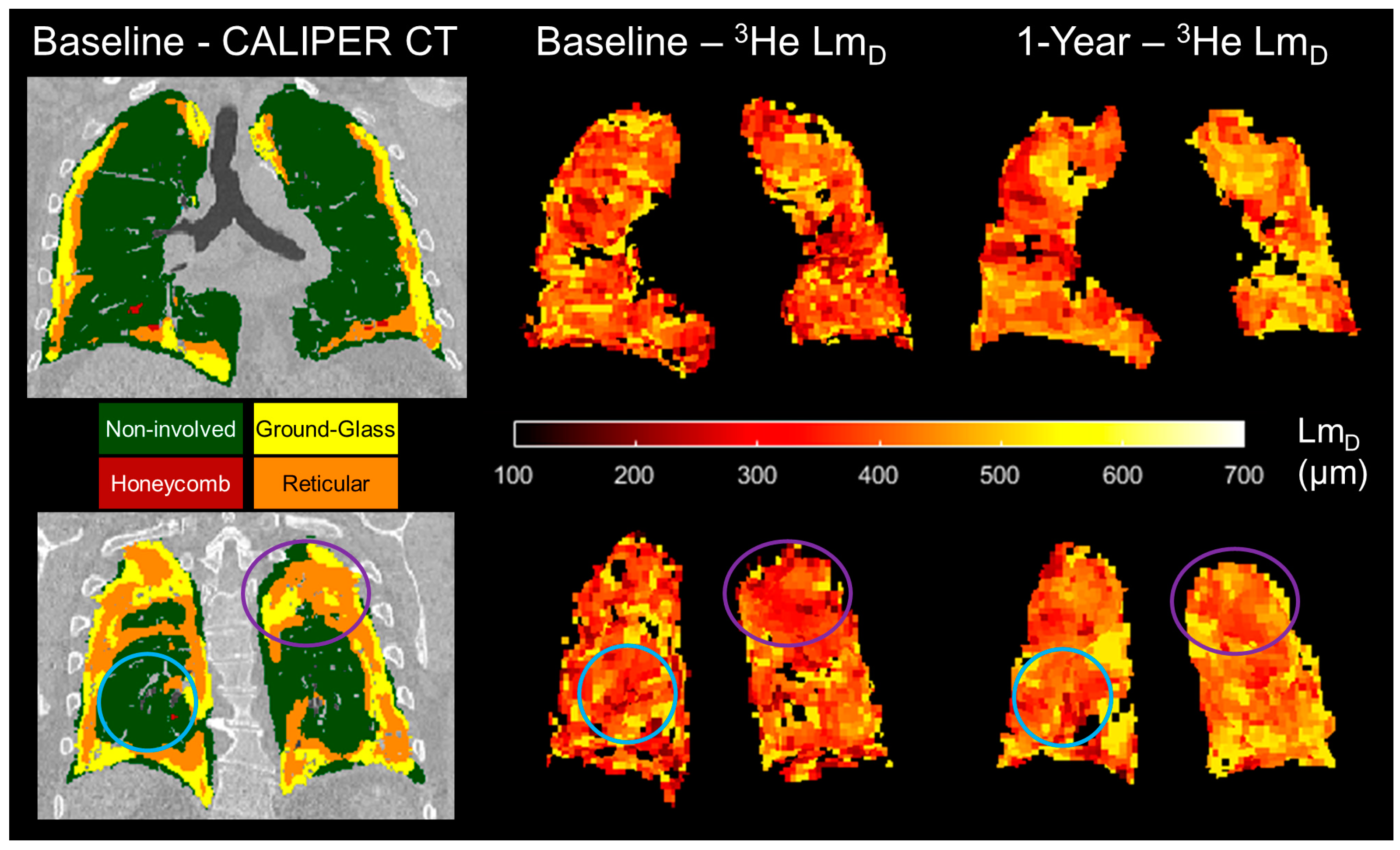Voxel-Wise Comparison of Co-Registered Quantitative CT and Hyperpolarised Gas Diffusion-Weighted MRI Measurements in IPF
Abstract
:1. Introduction
2. Materials and Methods
2.1. Study Participants
2.2. MRI and CT Image Acquisition
2.3. Image Registration and Analysis
2.4. Statistical Analyses
3. Results
3.1. Spatial Co-Registration
3.2. Baseline Voxel Comparison
3.3. Longitudinal Voxel Comparison
4. Discussion
5. Conclusions
Supplementary Materials
Author Contributions
Funding
Institutional Review Board Statement
Informed Consent Statement
Data Availability Statement
Acknowledgments
Conflicts of Interest
References
- Gross, T.J.; Hunninghake, G.W. Idiopathic Pulmonary Fibrosis. N. Engl. J. Med. 2001, 345, 517–525. [Google Scholar] [CrossRef]
- Raghu, G.; Collard, H.R.; Egan, J.J.; Martinez, F.J.; Behr, J.; Brown, K.K.; Colby, T.V.; Cordier, J.-F.; Flaherty, K.R.; Lasky, J.A.; et al. An Official ATS/ERS/JRS/ALAT Statement: Idiopathic Pulmonary Fibrosis: Evidence-based Guidelines for Diagnosis and Management. Am. J. Respir. Crit. Care Med. 2011, 183, 788–824. [Google Scholar] [CrossRef]
- Raghu, G.; Remy-Jardin, M.; Myers, J.L.; Richeldi, L.; Ryerson, C.J.; Lederer, D.J.; Behr, J.; Cottin, V.; Danoff, S.K.; Morell, F.; et al. Diagnosis of Idiopathic Pulmonary Fibrosis. An Official ATS/ERS/JRS/ALAT Clinical Practice Guideline. Am. J. Respir. Crit. Care Med. 2018, 198, e44–e68. [Google Scholar] [CrossRef]
- Lynch, D.A.; Sverzellati, N.; Travis, W.D.; Brown, K.K.; Colby, T.V.; Galvin, J.R.; Goldin, J.G.; Hansell, D.M.; Inoue, Y.; Johkoh, T.; et al. Diagnostic criteria for idiopathic pulmonary fibrosis: A Fleischner Society White Paper. Lancet Respir. Med. 2018, 6, 138–153. [Google Scholar] [CrossRef]
- Travis, W.D.; Costabel, U.; Hansell, D.M.; King, T.E., Jr.; Lynch, D.A.; Nicholson, A.G.; Ryerson, C.J.; Ryu, J.H.; Selman, M.; Wells, A.U.; et al. An official American Thoracic Society/European Respiratory Society statement: Update of the international multidisciplinary classification of the idiopathic interstitial pneumonias. Am. J. Respir. Crit. Care Med. 2013, 188, 733–748. [Google Scholar] [CrossRef]
- Ley, B.; Elicker, B.M.; Hartman, T.E.; Ryerson, C.J.; Vittinghoff, E.; Ryu, J.H.; Lee, J.S.; Jones, K.D.; Richeldi, L.; King, T.E.; et al. Idiopathic pulmonary fibrosis: CT and risk of death. Radiology 2014, 273, 570–579. [Google Scholar] [CrossRef]
- Best, A.C.; Meng, J.; Lynch, A.M.; Bozic, C.M.; Miller, D.; Grunwald, G.K.; Lynch, D.A. Idiopathic Pulmonary Fibrosis: Physiologic Tests, Quantitative CT Indexes, and CT Visual Scores as Predictors of Mortality. Radiology 2008, 246, 935–940. [Google Scholar] [CrossRef]
- Watadani, T.; Sakai, F.; Johkoh, T.; Noma, S.; Akira, M.; Fujimoto, K.; Bankier, A.A.; Lee, K.S.; Müller, N.L.; Song, J.-W.; et al. Interobserver Variability in the CT Assessment of Honeycombing in the Lungs. Radiology 2013, 266, 936–944. [Google Scholar] [CrossRef]
- Asakura, A.; Gotoh, T.; Iwasawa, T.; Saitoh, K.; Akasaka, H. Classification System of the CT Images with Non-Specific Interstitial Pneumonia. J. Inst. Image Electron. Eng. Jpn. 2004, 33, 180–188. [Google Scholar] [CrossRef]
- Rosas, I.O.; Yao, J.; Avila, N.A.; Chow, C.K.; Gahl, W.A.; Gochuico, B.R. Automated Quantification of High-Resolution CT Scan Findings in Individuals at Risk for Pulmonary Fibrosis. Chest 2011, 140, 1590–1597. [Google Scholar] [CrossRef]
- Uppaluri, R.; Hoffman, E.A.; Sonka, M.; Hunninghake, G.W.; McLENNAN, G. Interstitial Lung Disease: A quantitative study using the adaptive multiple feature method. Am. J. Respir. Crit. Care Med. 1999, 159, 519–525. [Google Scholar] [CrossRef]
- Bartholmai, B.J.; Raghunath, S.; Karwoski, R.A.B.; Moua, T.; Rajagopalan, S.; Maldonado, F.; Decker, P.A.M.; Robb, R.A. Quantitative Computed Tomography Imaging of Interstitial Lung Diseases. J. Thorac. Imaging 2013, 28, 298–307. [Google Scholar] [CrossRef]
- Humphries, S.M.; Yagihashi, K.; Huckleberry, J.; Rho, B.-H.; Schroeder, J.D.; Strand, M.; Schwarz, M.I.; Flaherty, K.R.; Kazerooni, E.A.; van Beek, E.J.R.; et al. Idiopathic Pulmonary Fibrosis: Data-driven Textural Analysis of Extent of Fibrosis at Baseline and 15-Month Follow-up. Radiology 2017, 285, 270–278. [Google Scholar] [CrossRef]
- Kim, H.J.; Brown, M.S.; Chong, D.; Gjertson, D.W.; Lu, P.; Kim, H.J.; Coy, H.; Goldin, J.G. Comparison of the Quantitative CT Imaging Biomarkers of Idiopathic Pulmonary Fibrosis at Baseline and Early Change with an Interval of 7 Months. Acad. Radiol. 2015, 22, 70–80. [Google Scholar] [CrossRef]
- Park, H.J.; Lee, S.M.; Song, J.W.; Oh, S.Y.; Kim, N.; Seo, J.B. Texture-Based Automated Quantitative Assessment of Regional Patterns on Initial CT in Patients With Idiopathic Pulmonary Fibrosis: Relationship to Decline in Forced Vital Capacity. Am. J. Roentgenol. 2016, 207, 976–983. [Google Scholar] [CrossRef]
- Salisbury, M.L.; Lynch, D.A.; van Beek, E.J.R.; Kazerooni, E.A.; Guo, J.; Xia, M.; Murray, S.; Anstrom, K.J.; Yow, E.; Martinez, F.J.; et al. Idiopathic Pulmonary Fibrosis: The Association between the Adaptive Multiple Features Method and Fibrosis Outcomes. Am. J. Respir. Crit. Care Med. 2017, 195, 921–929. [Google Scholar] [CrossRef]
- Hahn, A.D.; Carey, K.J.; Barton, G.P.; Torres, L.A.; Kammerman, J.; Cadman, R.V.; Lee, K.E.; Schiebler, M.L.; Sandbo, N.; Fain, S.B. Hyperpolarized 129Xe MR Spectroscopy in the Lung Shows 1-year Reduced Function in Idiopathic Pulmonary Fibrosis. Radiology 2022, 305, 688–696. [Google Scholar] [CrossRef]
- Jiao, X.-Y.; Song, H.; Liu, W.-W.; Yang, J.-L.; Wang, Z.-W.; Yang, D.; Huang, S. The effect of CALIPER-derived parameters for idiopathic pulmonary fibrosis in predicting prognosis, progression, and mortality: A systematic review. Eur. Radiol. 2023, 1–12. [Google Scholar] [CrossRef]
- Procter, A.J.; Jacob, J. Visual vs. computer-based computed tomography analysis for the identification of functional patterns in interstitial lung diseases. Curr. Opin. Pulm. Med. 2019, 25, 426–433. [Google Scholar] [CrossRef]
- Kaushik, S.S.; Cleveland, Z.I.; Cofer, G.P.; Metz, G.; Beaver, D.; Nouls, J.; Kraft, M.; Auffermann, W.; Wolber, J.; McAdams, H.P.; et al. Diffusion-weighted hyperpolarized 129Xe MRI in healthy volunteers and subjects with chronic obstructive pulmonary disease. Magn. Reson. Med. 2010, 65, 1154–1165. [Google Scholar] [CrossRef]
- Saam, B.T.; Yablonskiy, D.A.; Kodibagkar, V.D.; Leawoods, J.C.; Gierada, D.S.; Cooper, J.D.; Lefrak, S.S.; Conradi, M.S. MR imaging of diffusion of 3He gas in healthy and diseased lungs. Magn. Reason. Med. 2000, 44, 174–179. [Google Scholar] [CrossRef]
- Kirby, M.; Ouriadov, A.; Svenningsen, S.; Owrangi, A.; Wheatley, A.; Etemad-Rezai, R.; Santyr, G.E.; McCormack, D.G.; Parraga, G. Hyperpolarized3 He and 129Xe magnetic resonance imaging apparent diffusion coefficients: Physiological relevance in older never- and ex-smokers. Physiol. Rep. 2014, 2, e12068. [Google Scholar] [CrossRef]
- Kirby, M.; Svenningsen, S.; Owrangi, A.; Wheatley, A.; Farag, A.; Ouriadov, A.; Santyr, G.E.; Etemad-Rezai, R.; Coxson, H.O.; McCormack, D.G.; et al. Hyperpolarized3He and129Xe MR Imaging in Healthy Volunteers and Patients with Chronic Obstructive Pulmonary Disease. Radiology 2012, 265, 600–610. [Google Scholar] [CrossRef]
- Schreiber, W.G.; Morbach, A.E.; Stavngaard, T.; Gast, K.K.; Herweling, A.; Søgaard, L.V.; Windirsch, M.; Schmiedeskamp, J.; Heussel, C.P.; Kauczor, H.-U. Assessment of lung microstructure with magnetic resonance imaging of hyperpolarized Helium-3. Respir. Physiol. Neurobiol. 2005, 148, 23–42. [Google Scholar] [CrossRef]
- Bink, A.; Hanisch, G.; Karg, A.; Vogel, A.; Katsaros, K.; Mayer, E.; Gast, K.K.; Kauczor, H.-U. Clinical aspects of the apparent diffusion coefficient in 3He MRI: Results in healthy volunteers and patients after lung transplantation. J. Magn. Reson. Imaging 2007, 25, 1152–1158. [Google Scholar] [CrossRef]
- Chan, H.-F.; Weatherley, N.D.; Johns, C.S.; Stewart, N.J.; Collier, G.J.; Bianchi, S.M.; Wild, J.M. Airway Microstructure in Idiopathic Pulmonary Fibrosis: Assessment at Hyperpolarized 3He Diffusion-weighted MRI. Radiology 2019, 291, 223–229. [Google Scholar] [CrossRef]
- Eaden, J.A.; Weatherley, N.D.; Chan, H.-F.; Collier, G.; Norquay, G.; Swift, A.J.; Rajaram, S.; Smith, L.J.; Bartholmai, B.J.; Bianchi, S.M.; et al. Hyperpolarised xenon-129 diffusion-weighted magnetic resonance imaging for assessing lung microstructure in idiopathic pulmonary fibrosis. ERJ Open Res. 2023, 9. [Google Scholar] [CrossRef]
- Tahir, B.A.; Swift, A.J.; Marshall, H.; Parra-Robles, J.; Hatton, M.Q.; Hartley, R.; Kay, R.; E Brightling, C.; Vos, W.; Wild, J.M.; et al. A method for quantitative analysis of regional lung ventilation using deformable image registration of CT and hybrid hyperpolarized gas/1H MRI. Phys. Med. Biol. 2014, 59, 7267–7277. [Google Scholar] [CrossRef]
- Doganay, O.; Matin, T.; Chen, M.; Kim, M.; McIntyre, A.; McGowan, D.R.; Bradley, K.M.; Povey, T.; Gleeson, F.V. Time-series hyperpolarized xenon-129 MRI of lobar lung ventilation of COPD in comparison to V/Q-SPECT/CT and CT. Eur. Radiol. 2018, 29, 4058–4067. [Google Scholar] [CrossRef]
- Mathew, L.; Wheatley, A.; Castillo, R.; Castillo, E.; Rodrigues, G.; Guerrero, T.; Parraga, G. Hyperpolarized (3)He Magnetic Resonance Imaging: Comparison with four-dimensional x-ray computed tomography imaging in lung cancer. Acad. Radiol. 2012, 19, 1546–1553. [Google Scholar] [CrossRef]
- Capaldi, D.P.; Zha, N.; Guo, F.; Pike, D.; McCormack, D.G.; Kirby, M.; Parraga, G. Pulmonary Imaging Biomarkers of Gas Trapping and Emphysema in COPD:3He MR Imaging and CT Parametric Response Maps. Radiology 2016, 279, 597–608. [Google Scholar] [CrossRef]
- MacNeil, J.L.; Capaldi, D.P.I.; Westcott, A.R.; Eddy, R.L.; Barker, A.L.; McCormack, D.G.; Kirby, M.; Parraga, G. Pulmonary Imaging Phenotypes of Chronic Obstructive Pulmonary Disease Using Multiparametric Response Maps. Radiology 2020, 295, 227–236. [Google Scholar] [CrossRef]
- Tafti, S.; Garrison, W.J.; Mugler, J.P.; Shim, Y.M.; Altes, T.A.; Mata, J.F.; de Lange, E.E.; Cates, G.D.; Ropp, A.M.; Wang, C.; et al. Emphysema Index Based on Hyperpolarized 3He or 129Xe Diffusion MRI: Performance and Comparison with Quantitative CT and Pulmonary Function Tests. Radiology 2020, 297, 201–210. [Google Scholar] [CrossRef]
- Petersson-Sjögren, M.; Chan, H.-F.; Collier, G.J.; Norquay, G.; Olsson, L.E.; Wollmer, P.; Löndahl, J.; Wild, J.M. Airspace Dimension Assessment (AiDA) by inhaled nanoparticles: Benchmarking with hyperpolarised 129Xe diffusion-weighted lung MRI. Sci. Rep. 2021, 11, 4721. [Google Scholar] [CrossRef]
- Ebner, L.; Kammerman, J.; Driehuys, B.; Schiebler, M.L.; Cadman, R.V.; Fain, S.B. The role of hyperpolarized 129xenon in MR imaging of pulmonary function. Eur. J. Radiol. 2016, 86, 343–352. [Google Scholar] [CrossRef]
- Chan, H.-F.; Stewart, N.J.; Norquay, G.; Collier, G.J.; Wild, J.M. 3D diffusion-weighted 129 Xe MRI for whole lung morphometry. Magn. Reson. Med. 2017, 79, 2986–2995. [Google Scholar] [CrossRef]
- Avants, B.B.; Tustison, N.J.; Song, G.; Cook, P.A.; Klein, A.; Gee, J.C. A reproducible evaluation of ANTs similarity metric performance in brain image registration. NeuroImage 2011, 54, 2033–2044. [Google Scholar] [CrossRef]
- Chefd’Hotel, C.; Hermosillo, G.; Faugeras, O. A variational approach to multi-modal image matching. Proceedings the IEEE Workshop on Variational and Level Set Methods in Computer Vision, Vancouver, BC, Canada, 13 July 2001; pp. 21–28. [Google Scholar]
- Avants, B.; Epstein, C.; Grossman, M.; Gee, J. Symmetric diffeomorphic image registration with cross-correlation: Evaluating automated labeling of elderly and neurodegenerative brain. Med. Image Anal. 2008, 12, 26–41. [Google Scholar] [CrossRef]
- Halaweish, A.F.; Hoffman, E.A.; Thedens, D.R.; Fuld, M.K.; Sieren, J.P.; van Beek, E.J.R. Effect of Lung Inflation Level on Hyperpolarized3He Apparent Diffusion Coefficient Measurements in Never-Smokers. Radiology 2013, 268, 572–580. [Google Scholar] [CrossRef]






| IPF | Healthy Volunteer | |
|---|---|---|
| No. of subjects | 16 | 6 |
| Sex | 14M, 2F | 4M, 2F |
| Age (years) | 70.6 ± 5.2 | 66.7 ± 2.8 |
| FEV1 (% predicted) | 79.2 ± 12.7 | 98.6 ± 8.8 |
| FVC (% predicted) | 79.9 ± 17.9 | 99.1 ± 11.8 |
| DLCO (% predicted) | 48.3 ± 20.9 | 108.1 ± 19.5 |
| Global ADC (cm2/s) * | 0.335 ± 0.075 | 0.038 ± 0.004 |
| Global LmD (µm) * | 384 ± 41 | 299 ± 19 |
| CALIPER Pattern | % of Voxels | 3He ADC (cm2/s) | 3He LmD (µm) |
|---|---|---|---|
| Non-involved | 78.9 | 0.323 ± 0.133 | 380 ± 89 |
| Ground-glass | 12.4 | 0.379 ± 0.169 | 404 ± 98 |
| Reticular | 5.5 | 0.385 ± 0.179 | 405 ± 96 |
| Hyperlucent | 2.7 | 0.437 ± 0.235 | 400 ± 95 |
| Honeycomb | 0.5 | 0.588 ± 0.213 | 473 ± 82 |
| Post hoc Tukey Tests | Mean Difference 3He ADC (cm2/s) (Column–Row) | |||||
|---|---|---|---|---|---|---|
| Non-Involved | Ground-Glass | Reticular | Hyperlucent | Honeycomb | ||
| Mean difference 3He LmD (µm) (row–column) | Non-involved | - | 0.056 *# (0.053, 0.059) | 0.063 *# (0.059, 0.066) | 0.115 *# (0.109, 0.121) | 0.268 *# (0.256, 0.280) |
| Ground-glass | 23.8 *# (22.0, 25.7) | - | 0.007 * nr (0.002, 0.011) | 0.059 *# (0.053, 0.065) | 0.212 *# (0.200, 0.224) | |
| Reticular | 24.9 *# (22.4, 27.4) | 1.1 (−1.9, 4.1) | - | 0.052 *# (0.045, 0.059) | 0.205 *# (0.193, 0.218) | |
| Hyperlucent | 20.1 *# (16.0, 24.3) | −3.7 (−8.1, 0.7) | −4.8 (−9.5, 0.0) | - | 0.153 *# (0.140, 0.166) | |
| Honeycomb | 94.7 *# (85.6, 103.8) | 70.9 *# (61.7, 80.2) | 69.9 *# (60.4, 79.3) | 74.6 *# (64.6, 84.6) | - | |
| Baseline | 1 Year | Mean Difference (1 Year—Baseline) | ||||
|---|---|---|---|---|---|---|
| 3He ADC (cm2/s) | 3He LmD (µm) | 3He ADC (cm2/s) | 3He LmD (µm) | 3He ADC (cm2/s) | 3He LmD (µm) | |
| Non-involved | 0.313 ± 0.124 | 375 ± 88 | 0.315 ± 0.115 | 380 ± 81 | 0.002 * nr (0.001, 0.003) | 5.1 * nr (4.4, 5.8) |
| Ground-glass | 0.358 ± 0.163 | 391 ± 97 | 0.387 ± 0.168 | 411 ± 92 | 0.029 * nr (0.025, 0.033) | 19.8 *# (17.2, 22.4) |
| Reticular | 0.337 ± 0.138 | 389 ± 89 | 0.375 ± 0.143 | 414 ± 84 | 0.038 *# (0.033, 0.043) | 25.2 *# (22.0, 28.4) |
| Hyperlucent | 0.396 ± 0.213 | 389 ± 92 | 0.397 ± 0.205 | 397 ± 84 | 0.001 (−0.008, 0.010) | 7.3 * nr (3.2, 11.5) |
| Honeycomb | 0.595 ± 0.218 | 472 ± 85 | 0.622 ± 0.220 | 476 ± 78 | 0.027 (−0.007, 0.062) | 4.2 (−11.7, 20.2) |
| Global | 0.320 ± 0.134 | 377 ± 90 | 0.326 ± 0.128 | 385 ± 83 | 0.005 * nr (0.004, 0.006) | 7.4 * nr (6.8, 8.1) |
Disclaimer/Publisher’s Note: The statements, opinions and data contained in all publications are solely those of the individual author(s) and contributor(s) and not of MDPI and/or the editor(s). MDPI and/or the editor(s) disclaim responsibility for any injury to people or property resulting from any ideas, methods, instructions or products referred to in the content. |
© 2023 by the authors. Licensee MDPI, Basel, Switzerland. This article is an open access article distributed under the terms and conditions of the Creative Commons Attribution (CC BY) license (https://creativecommons.org/licenses/by/4.0/).
Share and Cite
Chan, H.-F.; Weatherley, N.D.; Biancardi, A.M.; Johns, C.S.; Tahir, B.A.; Karwoski, R.A.; Bartholmai, B.J.; Bianchi, S.M.; Wild, J.M. Voxel-Wise Comparison of Co-Registered Quantitative CT and Hyperpolarised Gas Diffusion-Weighted MRI Measurements in IPF. Diagnostics 2023, 13, 3497. https://doi.org/10.3390/diagnostics13233497
Chan H-F, Weatherley ND, Biancardi AM, Johns CS, Tahir BA, Karwoski RA, Bartholmai BJ, Bianchi SM, Wild JM. Voxel-Wise Comparison of Co-Registered Quantitative CT and Hyperpolarised Gas Diffusion-Weighted MRI Measurements in IPF. Diagnostics. 2023; 13(23):3497. https://doi.org/10.3390/diagnostics13233497
Chicago/Turabian StyleChan, Ho-Fung, Nicholas D. Weatherley, Alberto M. Biancardi, Christopher S. Johns, Bilal A. Tahir, Ronald A. Karwoski, Brian J. Bartholmai, Stephen M. Bianchi, and Jim M. Wild. 2023. "Voxel-Wise Comparison of Co-Registered Quantitative CT and Hyperpolarised Gas Diffusion-Weighted MRI Measurements in IPF" Diagnostics 13, no. 23: 3497. https://doi.org/10.3390/diagnostics13233497







